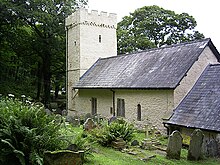St Illtyd's Church (Oxwich)
The St Illtyd's Church is a cultural monument of Category Grade II * listed Medieval church on the Gower Peninsula in Wales .
location
The church is tucked away in a walled square churchyard 1 km southeast of the village of Oxwich in the woods on the headland of Oxwich Point. The church overlooks Oxwich Bay , and a footpath leads to the coast.
history
Allegedly, there was already a Christian church in the 6th century on the site of the church consecrated to the Celtic saint Illtyd ( Illtud ). The present church dates largely from the 13th century. The nave was later expanded, probably in the 14th century, when the west tower was also built.
The church has been restored several times. A major restoration took place in 1892 at the instigation of the daughters of Christopher Rice Mansel Talbot , who had a country estate in nearby Penrice Castle . The windows were enlarged, the floor and roof renewed and the sacristy added to the south side of the choir.
The church today belongs to the Parish of South West Gower , a parish of the Diocese of Swansea and Brecon of the Church, together with St Andrew's Church in neighboring Penrice , St Mary's in Rhossili , St Cattwg's in Port Eynon, St David's in Llanddewi and St George's in Reynoldston in Wales . The interior of the church can be viewed outside of the services on request.
Building description
The single-nave church has a slate roof and is built from quarry stone; from the outside, the different wall thicknesses of the nave indicate the two construction phases. The north side is plastered, the entrance to the church is in the crenellated, five-storey west tower. In the entrance to the tower, two tombstones from the 13th and 14th centuries are embedded in the wall, which were originally set in the floor of the nave and represent two members of the de la Mere family , who were lords of Oxwich Manor at the time. The bell in the west tower dates from the 14th century, its inscription is similar to the inscription on the bells of Rhossili.
The tiny choir is the oldest surviving part of the small church and is said to be part of the cell from the 6th century, but there is no evidence for this. The narrow Norman choir arch indicates a building from the 12th century, the unusually small choir an older origin. The wooden vaulted ceiling dates from the 19th century, as well as the neo-Gothic choir window and the irregular windows of the nave. A wooden crucifixion group made in 1926 is located above the choir arch. The wooden high altar is neo-Gothic, the choir ceiling was painted in 1931 at the suggestion of Leslie Young , the artistic director of Sadler's Wells Theater in London, who spent his vacation in Oxwich. The font from Sutton Stone is said to have been placed in the church by the Celtic saint Illtyd, it was rebuilt in 1890 and 1923 and placed in its current location in the southwest corner of the church. On the north side of the ship there are two lying grave monuments in a niche depicting a knight in armor and his wife. According to tradition, there are two members of the de la Mere family who are believed to have drowned in Oxwich Bay in the early 14th century. According to another interpretation, they represent Sir John Penres and his wife Margaret Fleming, lords of Oxwich Castle in the 15th century .
Others
In the upper churchyard there is a well that has been dry for a long time and is said to have been haunted. A white ghost horse is said to have been seen in the churchyard, which then disappeared into the water of the fountain.
Web links
Individual evidence
- ^ Cadw Listed Building Database Record: Church of St Illtyd. Retrieved May 3, 2014 .
Coordinates: 51 ° 33 '13.3 " N , 4 ° 9' 28.1" W.
